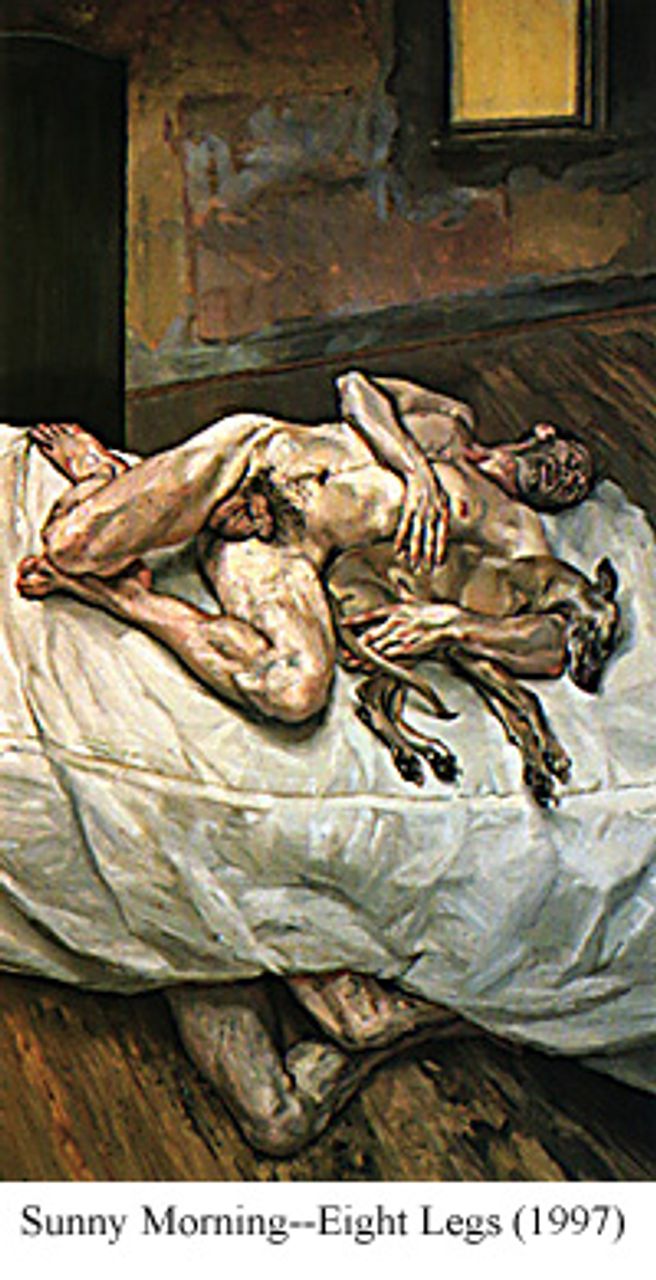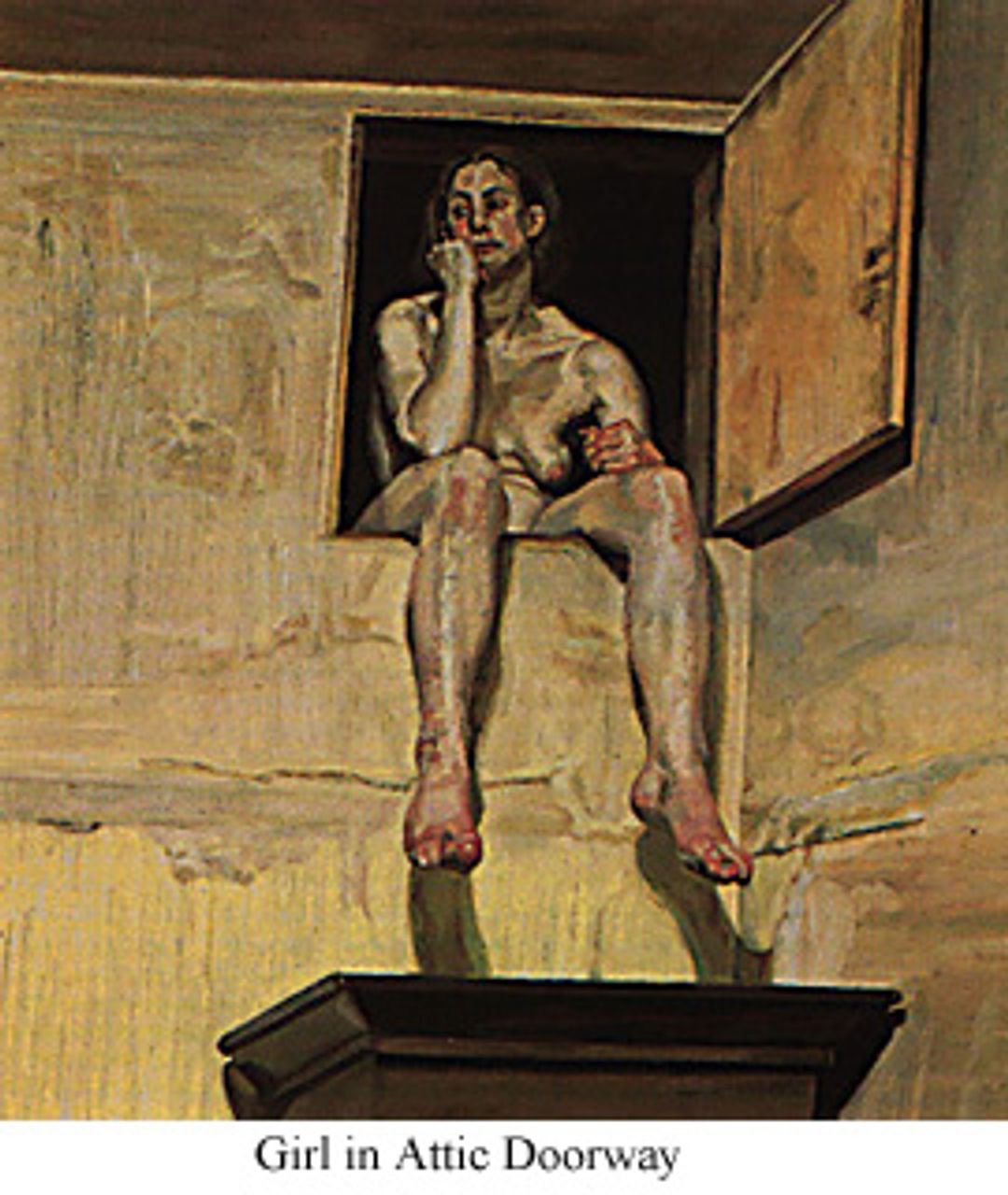This small exhibition, described by the artist as 'a showing not a show', is a rare chance to see twenty-five recent works by one of Britain's most celebrated contemporary artists. All but two, dating from 1992 onwards, are from private collections, and few have previously been seen in Britain. This is the first substantial body of Freud's work to be exhibited in London in five years.
Freud is best known for his approach to the human form. With heavy brush strokes and thick layers of paint, he produces figures that are not 'prettied up' for art. They are identifiably flesh-and-blood characters, often caught in awkward but perfectly natural poses.
Freud dislikes mystification, and this is embodied in his approach to the human body. As he puts it, 'I paint people not because of what they are like, not exactly in spite of what they are like, but how they happen to be.'
The small painting Esther and Albie, of a baby breast-feeding, demonstrates this well; the baby and the breast occupy the centre of the painting. They are not glorified, and there is no smoothing over of corporeal detail (veins stand out clearly).
Freud has been accused of preferring grotesque models, but he rather exalts the extra ordinariness of the ordinary. He has described his work as 'factual not literal', and this sums up his ability to catch his subjects' humanity. As he says, 'My models come in human guise.'
 Most of the pieces on display are paintings. The centrepiece of the exhibition is the large 1997 work Sunny Morning--Eight Legs which encapsulates many of the themes and styles of the rest of the display. Here a naked figure (modelled by the painter David Dawson) poses awkwardly on a bed holding a dog. Another pair of legs protrudes from under the bed. The dog is asleep, but the man holding her is awake and staring away from the viewer. The repose of the figures is not a comfortable one.
Most of the pieces on display are paintings. The centrepiece of the exhibition is the large 1997 work Sunny Morning--Eight Legs which encapsulates many of the themes and styles of the rest of the display. Here a naked figure (modelled by the painter David Dawson) poses awkwardly on a bed holding a dog. Another pair of legs protrudes from under the bed. The dog is asleep, but the man holding her is awake and staring away from the viewer. The repose of the figures is not a comfortable one.
In the display guide William Feaver, art critic for the Observer, suggested to Freud that by depicting the protruding legs, he was 'inserting a story, or symbolism.' Freud's answer is revealing of his greatest strength as a figure painter: 'The idea of a story doesn't bother me because everything's a story. But the idea of symbolism: I hate mystification.' He contrasted his views with those of Andy Warhol, who said of his own work that, 'They are exactly as they seem; there is nothing behind them.' 'I want there to be everything behind mine,' says Freud.
His awareness that every subject has a story, that it is part of some sort of external process, informs all of the figurative work in this display. Freud acknowledges that all of his subjects bring with them their whole lives. He has said, 'What draws me to paint them is the life in them. The life they're in.' Freud seeks to portray a moment of tranquillity during that life, rather than an artificial composition: 'I felt that the way I put things looked--not in a romantic way, I'd like to think--awkward in the way that life looks awkward'.
This is how he captures those brief moments of comfort in an uncomfortable position. In Pluto and the Bateman Sisters one of the figures sits on her calves with her feet pointing outwards. It is, the viewer knows, perfectly comfortable for her at the time of posing, but she can't sit like that forever. In Portrait on a Red Sofa the model sprawls face down, her legs trailing behind her. In Annabel and Rattler the model looks coolly at the viewer, propped up on the bed, appearing to be in an act of choosing when she will get up again. It is a suspended moment of comfort that the artist has caught. It is for this reason that Freud has talked of the 'urgency' of his paintings. They are alive with suspended movement.
Freud contends that in his figure painting he is simply recording the self-contained story of his models' lives. 'If I'm putting someone in a picture,' he explains, 'I like to feel that they've fallen asleep there or they've elbowed their way in; that way, they are there not to make the picture easy on the eye or more pleasant, but they are occupying the space of my picture and I am recording them.'
 Freud is sufficiently humanistic to record the life that they carry within them, but not interested in telling the story of that life. In a light and unhurried picture like Girl in Attic Doorway, for example, he simply records the peaceful scene. The nude may be waiting for some event, or she may not, but that is not Freud's concern. In spite of his talk of urgency, this is why some critics have seen in his work only the repose and not the movement it contains. William Feaver said to him, 'When you talk about urgency it's pretty tortoise-like,' to which he replied, 'Not to another tortoise.'
Freud is sufficiently humanistic to record the life that they carry within them, but not interested in telling the story of that life. In a light and unhurried picture like Girl in Attic Doorway, for example, he simply records the peaceful scene. The nude may be waiting for some event, or she may not, but that is not Freud's concern. In spite of his talk of urgency, this is why some critics have seen in his work only the repose and not the movement it contains. William Feaver said to him, 'When you talk about urgency it's pretty tortoise-like,' to which he replied, 'Not to another tortoise.'
This is apparent in some of his medium and large paintings of women sitting. In Ib Reading the catching of a moment of repose is evident. She has her bare feet up on another chair, her book is open on her lap. In the beautiful Bella the model also has bare feet as she relaxes into her worn and frayed armchair. Because of the perspective (face on, viewing the figure from slightly above) she appears to be sinking back into the empty room. It is clearly a tranquil pose, yet the figure remains alert. He uses a similar viewpoint for Louisa, but here the figure occupies more of the frame. The model is much more self-composed and self-contained. She appears to be catching her breath. It is only in a portrait like Gaz where the model's self-awareness and confidence brings the weight of the sitter's story to life. Elsewhere it is present but not explored, as in the two contrasting 'Susanna' pictures.
This isolation of a moment, and its shortcomings as a stylistic device, are also apparent in the two pieces in the exhibition which are not figurative. The large Garden, Notting Hill Gate has no one point of focus. A huge mass of buddleia and bamboo swirls before the viewer. Freud has talked of painting it as being a race against autumn, but in spite of the butterflies lurking within it, it lacks the sense of motion that his figures have. The only movement in the picture comes from the eye.
He allows the garden to contain its story the way he allows his models to contain theirs, and it inevitably fails to convey the same warmth. It is undoubtedly a technical tour de force, and there is perhaps a sense in which it was the painter's challenge to himself. He has talked of not wanting his work to trail off, of hoping to 'paint myself to death,' but this painting does not carry the same emotional weight as his figures.
This is interesting because it is not the case with the other non-figurative work in the display, Armchair by the Fire. The armchair, like much of the other furniture that turns up in his figure paintings, is heavily worn. The seat is sagging, the cover frayed. Standing alone beside an empty grate it could quite easily be a bleak picture. But it is not. Even without knowing that the chair had turned up in other works (Louisa is seated in it, for example) it has evidently been worn by human touch. It is informed by an external humanity, a humanity other than the painter's, in a way that the garden is not. It comes as no surprise to learn that Freud describes his reasons for loving the chair as, 'who sat in it. The life it's led. Slight feeling of sweat.' It illuminates perfectly the artist's strengths.
Freud is best known as a painter, but the display does give a chance to see a handful of etchings and one drawing. They are not of the same quality as his paintings, but they do illustrate how he pursues the same themes in other media. His charcoal portrait of Isaiah Berlin shows the old man almost asleep, while the two etchings, Woman with an Arm Tattoo and Woman Asleep explore the uneven flesh tone of a fat model. Less successful is his etching of David Dawson, but even here the ugliness of the face is permeated with intelligence and life. It may be that the etchings do not work as well as the paintings because the medium lacks the range of expression Freud needs for what he does so well, conveying the flesh-and-blood qualities of his subjects.
It is Freud's unglamourised representation of humanity that makes this display well worth seeing. His attempt to demystify the human form whilst recording the stories of his subjects marks a significant stance against the vacuity of much of contemporary art, which refuses to acknowledge even the existence of such stories and glorifies only the visible form. Even though he does not explore those stories, the fact that Freud records their presence within his subjects makes his work compellingly humane.
